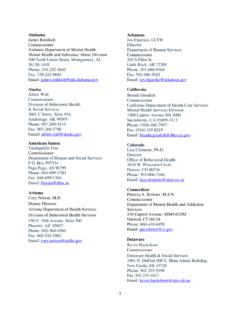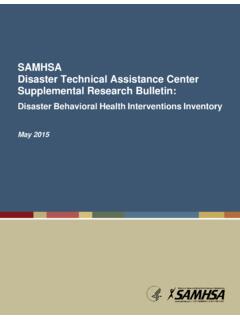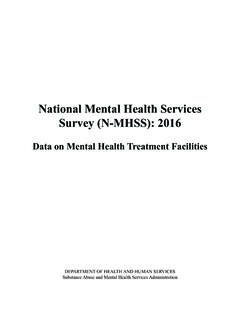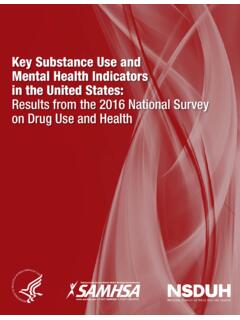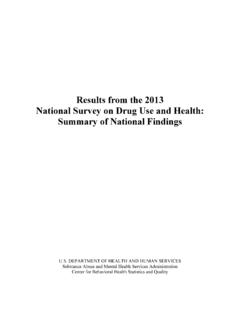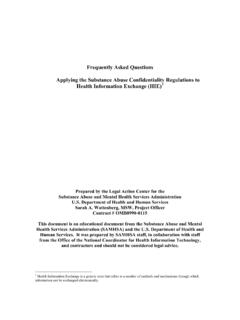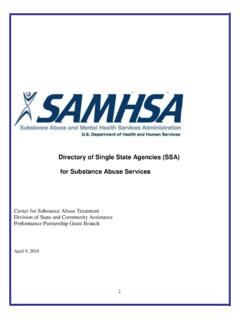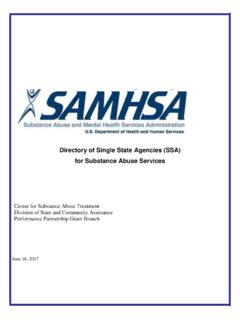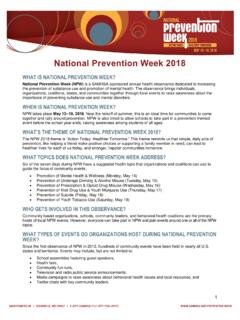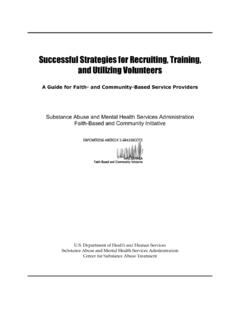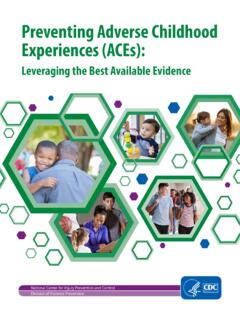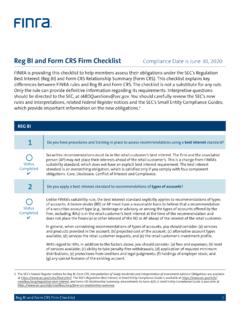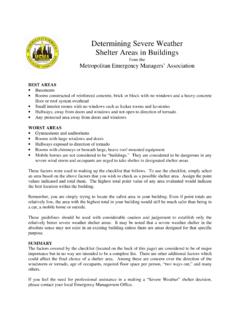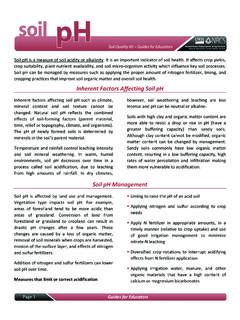Transcription of National Guidelines for Behavioral Health Crisis Care
1 National Guidelines for Behavioral Health Crisis Care A best Practice Toolkit Knowledge Informing Transformation Page 1 of 12 National Guidelines for Behavioral Health Crisis Care best Practice Toolkit Executive Summary National Guidelines for Behavioral Health Crisis Care A best Practice Toolkit Knowledge Informing Transformation Page 2 of 12 The National Guidelines for Crisis Care A best Practice Toolkit advances National Guidelines in Crisis care within a toolkit that supports program design, development, implementation and continuous quality improvement efforts. It is intended to help mental Health authorities, agency administrators, service providers, state and local leaders think through and develop the structure of Crisis systems.
2 The toolkit includes distinct sections for: Defining National Guidelines in Crisis care; Implementing care that aligns with National Guidelines ; and Evaluating alignment of systems to National the ever-expanding inclusion of the term Crisis by entities describing service offerings that do not truly function as no-wrong-door safety net services, we start by defining what Crisis services are and what they are not. Crisis services are for anyone, anywhere and anytime. Crisis services include (1) Crisis lines accepting all calls and dispatching support based on the assessed need of the caller, (2) mobile Crisis teams dispatched to wherever the need is in the community (not hospital emergency departments) and (3) Crisis receiving and stabilization facilities that serve everyone that comes through their doors from all referral sources.
3 These services are for anyone, anywhere and anytime. With non-existent or inadequate Crisis care, costs escalate due to an overdependence on restrictive, longer-term hospital stays, hospital readmissions, overuse of law enforcement and human tragedies that result from a lack of access to care. Extremely valuable psychiatric inpatient assets are over-burdened with referrals that might be best -supported with less intrusive, less expensive services and supports. In too many communities, the Crisis system has been unofficially handed over to law enforcement; sometimes with devastating outcomes. The current approach to Crisis care is patchwork and delivers minimal treatment for some people while others, often those who have not been engaged in care, fall through the cracks; resulting in multiple hospital readmissions, life in the criminal justice system, homelessness, early death and even suicide.
4 A comprehensive and integrated Crisis network is the first line of defense in preventing tragedies of public and patient safety, civil rights, extraordinary and unacceptable loss of lives, and the waste of resources. There is a better way. Effective Crisis care that saves lives and dollars requires a systemic approach. This toolkit will delineate how to estimate the Crisis system resource needs of a community, the number of individuals who can be served within the system, the cost of Crisis services, the workforce demands of implementing Crisis care and the community-changing impact that can be seen when services are delivered in a manner that aligns with this best Practice Toolkit.
5 Readers will also learn how this approach harnesses data and technology, draws on the expertise of those with lived experience, and incorporates evidence-based suicide prevention practices. National Guidelines for Behavioral Health Crisis Care A best Practice Toolkit Knowledge Informing Transformation Page 3 of 12 Core Services and best Practices The following represent the National Guidelines for Crisis Care essential elements within a no-wrong-door integrated Crisis system: Crisis Call Center: Regional 24/7 clinically staffed hub/ Crisis call center that provides Crisis intervention capabilities (telephonic, text and chat).
6 Such a service should meet National Suicide Prevention Lifeline (NSPL) standards for risk assessment and engagement of individuals at imminent risk of suicide and offer quality coordination of Crisis care in real-time; Mobile Team Response: Mobile Crisis teams available to reach any person in the service area in his or her home, workplace, or any other community-based location of the individual in Crisis in a timely manner; and Receiving and Stabilization Facilities: Crisis stabilization facilities providing short-term (under 24 hours) observation and Crisis stabilization services to all referrals in a home-like, non-hospital environment.
7 In addition to the essential structural or programmatic elements of a Crisis system, the following list of essential qualities must be baked into comprehensive Crisis systems: 1. Addressing recovery needs, significant use of peers, and trauma-informed care; 2. Suicide safer care; 3. Safety and security for staff and those in Crisis ; and 4. Law enforcement and emergency medical services collaboration. Regional Crisis Call Hub Services Someone To Talk To Regional, 24/7, clinically staffed call hub/ Crisis call centers provide telephonic Crisis intervention services to all callers, meet National Suicide Prevention Lifeline (NSPL) operational standards regarding suicide risk assessment and engagement and offer quality coordination of Crisis care in real-time.
8 Ideally, these programs will also offer text and chat options to better engage entire communities in care. Mental Health , substance use and suicide prevention lines must be equipped to take all calls with expertise in delivering telephonic intervention services, triaging the call to assess for additional needs and coordinating connections to additional support based on the assessment of the team and the preferences of the caller. Minimum Expectations to Operate a Regional Crisis Call Service 1. Operate every moment of every day (24/7/365); 2. Be staffed with clinicians overseeing clinical triage and other trained team members to respond to all calls received; 3.
9 Answer every call or coordinate overflow coverage with a resource that also meets all of the minimum Crisis call center expectations defined in this toolkit; 4. Assess risk of suicide in a manner that meets NSPL standards and danger to others within each call; National Guidelines for Behavioral Health Crisis Care A best Practice Toolkit Knowledge Informing Transformation Page 4 of 12 5. Coordinate connections to Crisis mobile team services in the region; and 6. Connect individuals to facility-based care through warm hand-offs and coordination of transportation as needed. best Practices to Operate Regional Crisis Call Center To fully align with best practice Guidelines , centers must meet the minimum expectations and: 1.
10 Incorporate Caller ID functioning; 2. Implement GPS-enabled technology in collaboration with partner Crisis mobile teams to more efficiently dispatch care to those in need; 3. Utilize real-time regional bed registry technology to support efficient connection to needed resources; and 4. Schedule outpatient follow-up appointments in a manner synonymous with a warm handoff to support connection to ongoing care following a Crisis episode. To align with National Suicide Prevention Lifeline (NSPL) operational standards, centers must: 1. Practice active engagement with callers and make efforts to establish sufficient rapport so as to promote the caller s collaboration in securing his/her own safety; 2.
